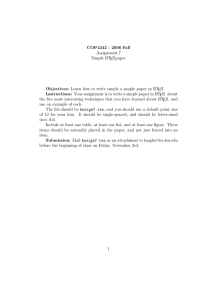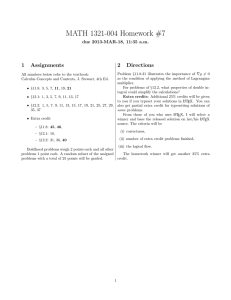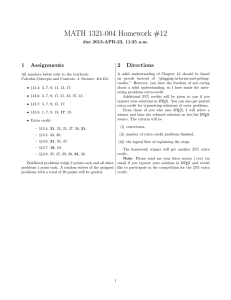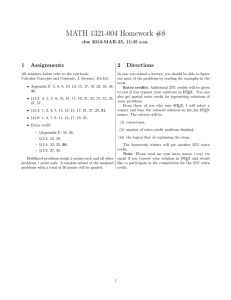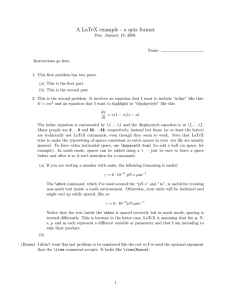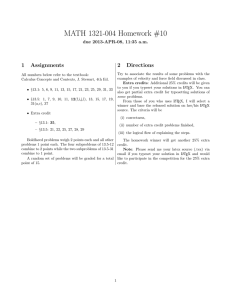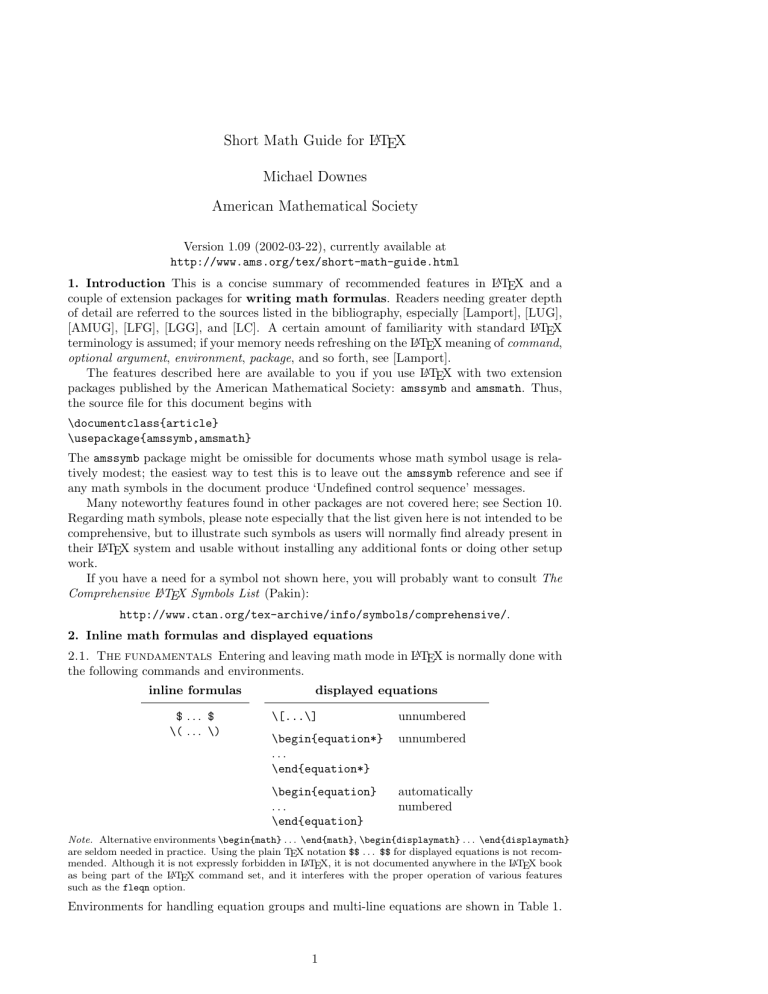
Short Math Guide for LATEX
Michael Downes
American Mathematical Society
Version 1.09 (2002-03-22), currently available at
http://www.ams.org/tex/short-math-guide.html
1. Introduction This is a concise summary of recommended features in LATEX and a
couple of extension packages for writing math formulas. Readers needing greater depth
of detail are referred to the sources listed in the bibliography, especially [Lamport], [LUG],
[AMUG], [LFG], [LGG], and [LC]. A certain amount of familiarity with standard LATEX
terminology is assumed; if your memory needs refreshing on the LATEX meaning of command,
optional argument, environment, package, and so forth, see [Lamport].
The features described here are available to you if you use LATEX with two extension
packages published by the American Mathematical Society: amssymb and amsmath. Thus,
the source file for this document begins with
\documentclass{article}
\usepackage{amssymb,amsmath}
The amssymb package might be omissible for documents whose math symbol usage is relatively modest; the easiest way to test this is to leave out the amssymb reference and see if
any math symbols in the document produce ‘Undefined control sequence’ messages.
Many noteworthy features found in other packages are not covered here; see Section 10.
Regarding math symbols, please note especially that the list given here is not intended to be
comprehensive, but to illustrate such symbols as users will normally find already present in
their LATEX system and usable without installing any additional fonts or doing other setup
work.
If you have a need for a symbol not shown here, you will probably want to consult The
Comprehensive LATEX Symbols List (Pakin):
http://www.ctan.org/tex-archive/info/symbols/comprehensive/.
2. Inline math formulas and displayed equations
2.1. The fundamentals Entering and leaving math mode in LATEX is normally done with
the following commands and environments.
inline formulas
$ ... $
\( . . . \)
displayed equations
\[...\]
unnumbered
\begin{equation*}
...
\end{equation*}
unnumbered
\begin{equation}
...
\end{equation}
automatically
numbered
Note. Alternative environments \begin{math} . . . \end{math}, \begin{displaymath} . . . \end{displaymath}
are seldom needed in practice. Using the plain TEX notation $$ . . . $$ for displayed equations is not recommended. Although it is not expressly forbidden in LATEX, it is not documented anywhere in the LATEX book
as being part of the LATEX command set, and it interferes with the proper operation of various features
such as the fleqn option.
Environments for handling equation groups and multi-line equations are shown in Table 1.
1
Short Math Guide for LATEX, version 1.09 (2002-03-22)
2
Table 1: Multi-line equations and equation groups (vertical lines indicating nominal margins).
\begin{equation}\label{xx}
\begin{split}
a=b+c−d
a& =b+c-d\\
+e−f
& \quad +e-f\\
(2.1)
& =g+h\\
=g+h
& =i
=i
\end{split}
\end{equation}
\begin{multline}
a+b+c+d+e+f\\
+i+j+k+l+m+n
\end{multline}
\begin{gather}
a_1=b_1+c_1\\
a_2=b_2+c_2-d_2+e_2
\end{gather}
a+b+c+d+e+f
+i+j+k+l+m+n
\begin{align}
a_1& =b_1+c_1\\
a_2& =b_2+c_2-d_2+e_2
\end{align}
\begin{align}
a_{11}& =b_{11}&
a_{12}& =b_{12}\\
a_{21}& =b_{21}&
a_{22}& =b_{22}+c_{22}
\end{align}
\begin{flalign*}
a_{11}& =b_{11}&
a_{12}& =b_{12}\\
a_{21}& =b_{21}&
a_{22}& =b_{22}+c_{22}
\end{flalign*}
a1 = b1 + c1
a2 = b2 + c2 − d2 + e2
(2.3)
(2.4)
a1 = b1 + c1
a2 = b2 + c2 − d2 + e2
(2.5)
(2.6)
a11 = b11
a21 = b21
a11 = b11
a21 = b21
(2.2)
a12 = b12
a22 = b22 + c22
(2.7)
(2.8)
a12 = b12
a22 = b22 + c22
Note 1. The split environment is something of a special case. It is a subordinate environment that can
be used as the contents of an equation environment or the contents of one “line” in a multiple-equation
structure such as align or gather.
Note 2. The eqnarray and eqnarray* environments described in [Lamport] are not recommended because
they produce inconsistent spacing of the equal signs and make no attempt to prevent overprinting of the
equation body and equation number.
Short Math Guide for LATEX, version 1.09 (2002-03-22)
3
2.2. Automatic numbering and cross-referencing To get an auto-numbered equation, use the equation environment; to assign a label for cross-referencing, use the \label
command:
\begin{equation}\label{reio}
...
\end{equation}
To get a cross-reference to an auto-numbered equation, use the \eqref command:
... using equations \eqref{ax1} and \eqref{bz2}, we
can derive ...
The above example would produce something like
using equations (3.2) and (3.5), we can derive
In other words, \eqref{ax1} is equivalent to (\ref{ax1}).
To give your equation numbers the form m.n (section-number.equation-number ), use
the \numberwithin command in the preamble of your document:
\numberwithin{equation}{section}
For more details on custom numbering schemes see [Lamport, §6.3, §C.8.4].
The subequations environment provides a convenient way to number equations in a
group with a subordinate numbering scheme. For example, supposing that the current
equation number is 2.1, write
\begin{equation}\label{first}
a=b+c
\end{equation}
some intervening text
\begin{subequations}\label{grp}
\begin{align}
a&=b+c\label{second}\\
d&=e+f+g\label{third}\\
h&=i+j\label{fourth}
\end{align}
\end{subequations}
to get
a=b+c
(2.9)
some intervening text
a=b+c
d=e+f +g
h=i+j
(2.10a)
(2.10b)
(2.10c)
By putting a \label command immediately after \begin{subequations} you can get a
reference to the parent number; \eqref{grp} from the above example would produce (2.10)
while \eqref{second} would produce (2.10a).
3. Math symbols and math fonts
3.1. Classes of math symbols The symbols in a math formula fall into different classes
that correspond more or less to the part of speech each symbol would have if the formula
were expressed in words. Certain spacing and positioning cues are traditionally used for
the different symbol classes to increase the readability of formulas.
Short Math Guide for LATEX, version 1.09 (2002-03-22)
Class
number
0
1
2
3
4
5
6
Mnemonic
Description
(part of speech)
Ord
Op
Bin
Rel
Open
Close
Pun
simple/ordinary (“noun”)
prefix operator
binary operator (conjunction)
relation/comparison (verb)
left/opening delimiter
right/closing delimiter
postfix/punctuation
4
Examples
A
Φ∞
�
�0�
+∪∧
=<⊂
([{�
)]}�
.,;!
Note 1. The distinction in TEX between class 0 and an additional class 7 has to do only with font selection
issues and is immaterial here.
Note 2. Symbols of class Bin, notably the minus sign −, are automatically coerced to class 0 (no space) if
they do not have a suitable left operand.
The spacing for a few symbols follows tradition instead of the general rule: although /
is (semantically speaking) of class 2, we write k/2 with no space around the slash rather
than k / 2. And compare p|q p|q (no space) with p\mid q p | q (class-3 spacing).
The proper way to define a new math symbol is discussed in LATEX 2ε font selection
[LFG]. It is not really possible to give a useful synopsis here because one needs first to
understand the ramifications of font specifications.
3.2. Some symbols intentionally omitted here The following math symbols that
are mentioned in the LATEX book [Lamport] are intentionally omitted from this discussion
because they are superseded by equivalent symbols when the amssymb package is loaded.
If you are using the amssymb package anyway, the only thing that you are likely to gain by
using the alternate name is an unnecessary increase in the number of fonts used by your
document.
\Box,
\Diamond,
\leadsto,
\Join,
\lhd,
\unlhd,
\rhd,
\unrhd,
see
see
see
see
see
see
see
see
\square �
\lozenge ♦
\rightsquigarrow �
\bowtie ��
\vartriangleleft �
\trianglelefteq �
\vartriangleright �
\trianglerighteq �
Furthermore, there are many, many additional symbols available for LATEX use above
and beyond the ones included here. This list is not intended to be comprehensive. For a
much more comprehensive list of symbols, including nonmathematically oriented ones such
as phonetic alphabetic or dingbats, see The Comprehensive LATEX Symbols List (Pakin):
http://www.ctan.org/tex-archive/info/symbols/comprehensive/.
3.3. Latin letters and Arabic numerals The Latin letters are simple symbols, class 0.
The default font for them in math formulas is italic.
AB C DE F GH I J K LM N OP QRS T U V W X Y Z
abcdef ghij klmnopqrstuvwxyz
When adding an accent to an i or j in math, dotless variants can be obtained with \imath
and \jmath:
ı \imath
\jmath
̂ \hat{\jmath}
Arabic numerals 0–9 are also of class 0. Their default font is upright/roman.
0123456789
Short Math Guide for LATEX, version 1.09 (2002-03-22)
5
3.4. Greek letters Like the Latin letters, the Greek letters are simple symbols, class 0.
For obscure historical reasons, the default font for lowercase Greek letters in math formulas is italic while the default font for capital Greek letters is upright/roman. (In other
fields such as physics and chemistry, however, the typographical traditions are somewhat
different.) The capital Greek letters not present in this list are the letters that have the
same appearance as some Latin letter: A for Alpha, B for Beta, and so on. In the list of
lowercase letters there is no omicron because it would be identical in appearance to Latin o.
In practice, the Greek letters that have Latin look-alikes are seldom used in math formulas,
to avoid confusion.
Γ
∆
Λ
Φ
Π
Ψ
Σ
Θ
Υ
Ξ
Ω
\Gamma
\Delta
\Lambda
\Phi
\Pi
\Psi
\Sigma
\Theta
\Upsilon
\Xi
\Omega
α
β
γ
δ
�
ζ
η
θ
ι
κ
λ
µ
ν
\alpha
\beta
\gamma
\delta
\epsilon
\zeta
\eta
\theta
\iota
\kappa
\lambda
\mu
\nu
ξ
π
ρ
σ
τ
υ
φ
χ
ψ
ω
�
ε
κ
ϕ
�
�
ς
ϑ
\xi
\pi
\rho
\sigma
\tau
\upsilon
\phi
\chi
\psi
\omega
\digamma
\varepsilon
\varkappa
\varphi
\varpi
\varrho
\varsigma
\vartheta
3.5. Other alphabetic symbols These are also class 0.
ℵ
�
�
ג
\aleph
\beth
\daleth
\gimel
�
�
ð
�
\complement
\ell
\eth
\hbar
�
�
∂
℘
\hslash
\mho
\partial
\wp
�
k
�
�
\circledS
\Bbbk
\Finv
\Game
� \Im
� \Re
3.6. Miscellaneous simple symbols These symbols are also of class 0 (ordinary) which
means they do not have any built-in spacing.
#
&
∠
�
�
�
�
�
�
⊥
\#
\&
\angle
\backprime
\bigstar
\blacklozenge
\blacksquare
\blacktriangle
\blacktriangledown
\bot
♣
�
�
♦
∅
∃
�
∀
♥
∞
\clubsuit
\diagdown
\diagup
\diamondsuit
\emptyset
\exists
\flat
\forall
\heartsuit
\infty
♦
�
∇
�
¬
�
�
�
♠
�
\lozenge
\measuredangle
\nabla
\natural
\neg
\nexists
\prime
\sharp
\spadesuit
\sphericalangle
� \square
√
\surd
� \top
� \triangle
� \triangledown
∅ \varnothing
Note 1. A common mistake in the use of the symbols � and # is to try to make them serve as binary
operators or relation symbols without using a properly defined math symbol command. If you merely use
the existing commands \square or \# the inter-symbol spacing will be incorrect because those commands
produce a class-0 symbol.
Note 2. Synonyms: ¬ \lnot
Short Math Guide for LATEX, version 1.09 (2002-03-22)
6
3.7. Binary operator symbols
∗
+
−
�
∗
⊼
�
�
�
�
�
�
�
•
∩
�
*
+
\amalg
\ast
\barwedge
\bigcirc
\bigtriangledown
\bigtriangleup
\boxdot
\boxminus
\boxplus
\boxtimes
\bullet
\cap
\Cap
·
�
◦
�
�
�
∪
�
�
�
†
‡
�
÷
�
�
�
�
�
�
�
�
∓
⊙
�
⊕
�
⊗
±
�
�
\
\cdot
\centerdot
\circ
\circledast
\circledcirc
\circleddash
\cup
\Cup
\curlyvee
\curlywedge
\dagger
\ddagger
\diamond
\div
\divideontimes
\dotplus
\doublebarwedge
\gtrdot
\intercal
\leftthreetimes
\lessdot
\ltimes
\mp
\odot
\ominus
\oplus
\oslash
\otimes
\pm
\rightthreetimes
\rtimes
\setminus
�
�
�
�
×
�
�
�
∨
�
∧
�
\smallsetminus
\sqcap
\sqcup
\star
\times
\triangleleft
\triangleright
\uplus
\vee
\veebar
\wedge
\wr
Synonyms: ∧ \land, ∨ \lor, � \doublecup, � \doublecap
3.8. Relation symbols: < = > � ∼ and variants
<
=
>
≈
�
�
�
�
�
�
�
∼
=
�
�
.
=
�
�
�
�
<
=
>
\approx
\approxeq
\asymp
\backsim
\backsimeq
\bumpeq
\Bumpeq
\circeq
\cong
\curlyeqprec
\curlyeqsucc
\doteq
\doteqdot
\eqcirc
\eqsim
\eqslantgtr
�
≡
�
≥
�
�
�
≫
�
�
�
�
�
�
�
≷
�
�
≤
\eqslantless
\equiv
\fallingdotseq
\geq
\geqq
\geqslant
\gg
\ggg
\gnapprox
\gneq
\gneqq
\gnsim
\gtrapprox
\gtreqless
\gtreqqless
\gtrless
\gtrsim
\gvertneqq
\leq
�
�
�
�
�
≶
�
�
≪
�
�
�
�
�
�
�=
�
�
�
\leqq
\leqslant
\lessapprox
\lesseqgtr
\lesseqqgtr
\lessgtr
\lesssim
\ll
\lll
\lnapprox
\lneq
\lneqq
\lnsim
\lvertneqq
\ncong
\neq
\ngeq
\ngeqq
\ngeqslant
Synonyms: �= \ne, ≤ \le, ≥ \ge, � \Doteq, ≪ \llless, ≫ \gggtr
≯
�
�
�
≮
⊀
�
�
�
�
≺
�
�
�
�
�
�
�
�
\ngtr
\nleq
\nleqq
\nleqslant
\nless
\nprec
\npreceq
\nsim
\nsucc
\nsucceq
\prec
\precapprox
\preccurlyeq
\preceq
\precnapprox
\precneqq
\precnsim
\precsim
\risingdotseq
∼
�
�
�
�
�
�
�
�
�
≈
∼
�
\sim
\simeq
\succ
\succapprox
\succcurlyeq
\succeq
\succnapprox
\succneqq
\succnsim
\succsim
\thickapprox
\thicksim
\triangleq
Short Math Guide for LATEX, version 1.09 (2002-03-22)
7
3.9. Relation symbols: arrows See also Section 4.
�
�
�
�
�
�
�
←�
�→
←
⇐
�
�
�
⇔
↔
⇔
�
�
�
�
←−
⇐=
←→
⇐⇒
�−→
−→
=⇒
�
�
�
�→
�
�
�
�
�
�
�
�
\circlearrowleft
\circlearrowright
\curvearrowleft
\curvearrowright
\downdownarrows
\downharpoonleft
\downharpoonright
\hookleftarrow
\hookrightarrow
\leftarrow
\Leftarrow
\leftarrowtail
\leftharpoondown
\leftharpoonup
\leftleftarrows
\leftrightarrow
\Leftrightarrow
\leftrightarrows
\leftrightharpoons
\leftrightsquigarrow
\Lleftarrow
\longleftarrow
\Longleftarrow
\longleftrightarrow
\Longleftrightarrow
\longmapsto
\longrightarrow
\Longrightarrow
\looparrowleft
\looparrowright
\Lsh
\mapsto
\multimap
\nLeftarrow
\nLeftrightarrow
\nRightarrow
\nearrow
\nleftarrow
\nleftrightarrow
\nrightarrow
�
→
⇒
�
�
�
�
�
⇒
�
�
�
�
�
�
�
�
�
⇑
\nwarrow
\rightarrow
\Rightarrow
\rightarrowtail
\rightharpoondown
\rightharpoonup
\rightleftarrows
\rightleftharpoons
\rightrightarrows
\rightsquigarrow
\Rrightarrow
\Rsh
\searrow
\swarrow
\twoheadleftarrow
\twoheadrightarrow
\upharpoonleft
\upharpoonright
\upuparrows
Synonyms: ← \gets, → \to, � \restriction
3.10. Relation symbols: miscellaneous
�
∵
�
�
�
��
�
�
∈
|
|=
�
�
∈
/
∦
�
�
�
\backepsilon
\because
\between
\blacktriangleleft
\blacktriangleright
\bowtie
\dashv
\frown
\in
\mid
\models
\ni
\nmid
\notin
\nparallel
\nshortmid
\nshortparallel
\nsubseteq
�
�
�
�
�
�
�
�
�
�
�
�
⊥
�
∝
�
�
�
\nsubseteqq
\nsupseteq
\nsupseteqq
\ntriangleleft
\ntrianglelefteq
\ntriangleright
\ntrianglerighteq
\nvdash
\nVdash
\nvDash
\nVDash
\parallel
\perp
\pitchfork
\propto
\shortmid
\shortparallel
\smallfrown
�
�
�
�
�
�
⊂
�
⊆
�
�
�
⊃
�
⊇
�
�
�
\smallsmile
\smile
\sqsubset
\sqsubseteq
\sqsupset
\sqsupseteq
\subset
\Subset
\subseteq
\subseteqq
\subsetneq
\subsetneqq
\supset
\Supset
\supseteq
\supseteqq
\supsetneq
\supsetneqq
∴
�
�
∝
�
�
�
�
�
�
�
�
�
�
�
\therefore
\trianglelefteq
\trianglerighteq
\varpropto
\varsubsetneq
\varsubsetneqq
\varsupsetneq
\varsupsetneqq
\vartriangle
\vartriangleleft
\vartriangleright
\vdash
\Vdash
\vDash
\Vvdash
Synonyms: � \owns
3.11. Cumulative (variable-size) operators
�
�
� \int
� \bigodot
\oint
�
� \bigoplus
\bigcap
�
� \bigotimes
\bigcup
\bigsqcup
�
� \biguplus
� \bigvee
� \bigwedge
\coprod
�
\prod
∫ \smallint
�
\sum
Short Math Guide for LATEX, version 1.09 (2002-03-22)
8
3.12. Punctuation
.
/
|
,
.
/
|
,
;;
: \colon
::
!!
?
···
...
···
?
\dotsb
\dotsc
\dotsi
..
. \vdots
· · · \dotsm
. . . \dotso
..
. \ddots
Note 1. The : by itself produces a colon with class-3 (relation) spacing. The command \colon produces
special spacing for use in constructions such as f\colon A\to B f : A → B.
Note 2. Although the commands \cdots and \ldots are frequently used, we recommend the more semantically oriented commands \dotsb \dotsc \dotsi \dotsm \dotso for most purposes (see 4.6).
3.13. Pairing delimiters (extensible) See Section 6 for more information.
��
��
��
\lgroup \rgroup
( )
� � \lVert \rVert
��
��
\lmoustache \rmoustache
[ ]
\langle \rangle
��
��
\lbrace \rbrace
\lceil \rceil
��
��
��
\lfloor \rfloor
� � \lvert \rvert
3.14. Nonpairing extensible symbols
�
�
�
�
�
�
/
\backslash
� \vert
� \Vert
\arrowvert
�
�
� \Arrowvert
\bracevert
Note 1. Using \vert, |, \Vert, or \| for paired delimiters is not recommended (see 6.2).
Synonyms: � \|
3.15. Extensible vertical arrows
�
�
�
\uparrow
� \Uparrow
� \downarrow
�
�
� \Downarrow
�
� \updownarrow
�
�
� \Updownarrow
3.16. Accents
x́
x̀
ẍ
x̃
\acute{x}
\grave{x}
\ddot{x}
\tilde{x}
x̄
x̆
x̌
x̂
\bar{x}
\breve{x}
\check{x}
\hat{x}
�x
ẋ
ẍ
...
x
\vec{x}
\dot{x}
\ddot{x}
\dddot{x}
xxx
� \widetilde{xxx}
xxx
� \widehat{xxx}
3.17. Named operators These operators are represented by a multiletter abbreviation.
arccos
arcsin
arctan
arg
cos
cosh
cot
coth
\arccos
\arcsin
\arctan
\arg
\cos
\cosh
\cot
\coth
csc
deg
det
dim
exp
gcd
hom
inf
\csc
\deg
\det
\dim
\exp
\gcd
\hom
\inf
inj lim
ker
lg
lim
lim inf
lim sup
ln
log
\injlim
\ker
\lg
\lim
\liminf
\limsup
\ln
\log
max
min
Pr
proj lim
sec
sin
sinh
sup
\max
\min
\Pr
\projlim
\sec
\sin
\sinh
\sup
tan
tanh
lim
−→
lim
←−
lim
lim
\tan
\tanh
\varinjlim
\varprojlim
\varliminf
\varlimsup
To define additional named operators outside the above list, use the \DeclareMathOperator
command; for example, after
Short Math Guide for LATEX, version 1.09 (2002-03-22)
9
\DeclareMathOperator{\rank}{rank}
\DeclareMathOperator{\esssup}{ess\,sup}
one could write
\rank(x)
\esssup(y,z)
rank(x)
ess sup(y, z)
The star form \DeclareMathOperator* creates an operator that takes limits in a displayed
formula like sup or max.
When predefining such a named operator is problematic (e.g., when using one in the
title or abstract of an article), there is an alternative form that can be used directly:
\operatorname{rank}(x)
→
rank(x)
3.18. Math font switches Not all of the fonts necessary to support comprehensive
math font switching are commonly available in a typical LATEX setup. Here are the results
of applying various font switches to a wide range of math symbols when the standard set
of Computer Modern fonts is in use. It can be seen that the only symbols that respond
correctly to all of the font switches are the uppercase Latin letters. In fact, nearly all math
symbols apart from Latin letters remain unaffected by font switches; and although the
lowercase Latin letters, capital Greek letters, and numerals do respond properly to some
font switches, they produce bizarre results for other font switches. (Use of alternative math
font sets such as Lucida New Math may ameliorate the situation somewhat.)
default \mathbf
\mathsf
\mathit \mathcal
\mathbb
\mathfrak
X
X
§
�
x
�
0
X
X
X
X
x
x
x
x
0
0
0
0
[]
[]
[]
[]
[]
[]
[]
+
+
+
+
+
+
+
−
−
−
−
−
−
−
Ξ
Ξ
Ξ
Ξ
≮
�
ξ
ξ
ξ
ξ
÷
ξ
ξ
ξ
∞
∞
∞
∞
∞
∞
∞
=
=
=
=
X
�
=
=
=
ℵ
�
ℵ
�
ℵ
�
ℵ
�
ℵ
�
ℵ
�
ℵ
�
�
�
�
�
�
�
�
�
�
�
�
�
�
�
A common desire is to get a bold version of a particular math symbol. For those symbols
where \mathbf is not applicable, the \boldsymbol or \pmb commands can be used.
A∞ + πA0 ∼ A∞ + πA0 ∼ A∞ + π A0
(3.1)
A_\infty + \pi A_0
\sim \mathbf{A}_{\boldsymbol{\infty}} \boldsymbol{+}
\boldsymbol{\pi} \mathbf{A}_{\boldsymbol{0}}
\sim\pmb{A}_{\pmb{\infty}} \pmb{+}\pmb{\pi} \pmb{A}_{\pmb{0}}
The \boldsymbol command is obtained preferably by using the bm package, which provides
a newer, more powerful version than the one provided by the amsmath package. Generally
speaking, it is ill-advised to apply \boldsymbol to more than one symbol at a time.
Short Math Guide for LATEX, version 1.09 (2002-03-22)
10
3.18.1. Calligraphic letters (cmsy; no lowercase)
Usage: \mathcal{M}.
ABC DE F G HI J KLMN OP QRS T U V W X Y Z
3.18.2. Blackboard Bold letters (msbm; no lowercase)
Usage: \mathbb{R}.
ABCDEFGHIJKLMNOPQRSTUVWXYZ
3.18.3. Fraktur letters (eufm)
Usage: \mathfrak{S}.
ABCDEFGHIJKLMNOPQRSTUVWXYZ
abcdefghijklmnopqrstuvwxyz
4. Notations
4.1. Top and bottom embellishments These are visually similar to accents but generally span multiple symbols rather than being applied to a single base symbol. For ease
of reference, \widetilde and \widehat are redundantly included here and in the table of
math accents.
����
xxx \overbrace{xxx}
xxx \underbrace{xxx}
����
←
−− \overleftarrow{xxx}
xxx
xxx
←−− \underleftarrow{xxx}
xxx
� \widetilde{xxx}
xxx
� \widehat{xxx}
xxx \overline{xxx}
xxx \underline{xxx}
−
−→
xxx
xxx
−−→
←
→
xxx
xxx
←→
\overrightarrow{xxx}
\underrightarrow{xxx}
\overleftrightarrow{xxx}
\underleftrightarrow{xxx}
4.2. Extensible arrows \xleftarrow and \xrightarrow produce arrows that extend
automatically to accommodate unusually wide subscripts or superscripts. These commands
take one optional argument (the subscript) and one mandatory argument (the superscript,
possibly empty):
n+µ−1
n±i−1
(4.1)
A ←−−−−− B −−−−→ C
T
\xleftarrow{n+\mu-1}\quad \xrightarrow[T]{n\pm i-1}
4.3. Affixing symbols to other symbols In addition to the standard accents (Section 3.16), other symbols can be placed above or below a base symbol with the \overset and
\underset commands. For example, writing \overset{*}{X} will place a superscript-size
∗
∗ above the X, thus: X. See also the description of \sideset in Section 8.4.
4.4. Matrices The environments pmatrix, bmatrix, Bmatrix, vmatrix and Vmatrix
have (respectively) ( ), [ ], { }, | |, and � � delimiters built in. There is also a matrix environment sans delimiters, and an array environment that can be used to obtain left alignment
or other variations in the column specs.
\begin{pmatrix}
\alpha& \beta^{*}\\
\gamma^{*}& \delta
\end{pmatrix}
�
α
γ∗
β∗
δ
�
To produce
� � a small matrix suitable for use in text, there is a smallmatrix environment
(e.g., ac db ) that comes closer to fitting within a single text line than a normal matrix.
This example was produced by
Short Math Guide for LATEX, version 1.09 (2002-03-22)
11
\bigl( \begin{smallmatrix}
a&b\\ c&d
\end{smallmatrix} \bigr)
To produce a row of dots in a matrix spanning a given number of columns, use \hdotsfor.
For example, \hdotsfor{3} in the second column of a four-column matrix will print a row
of dots across the final three columns.
For piece-wise function definitions there is a cases environment:
P_{r-j}=\begin{cases}
0& \text{if $r-j$ is odd},\\
r!\,(-1)^{(r-j)/2}& \text{if $r-j$ is even}.
\end{cases}
Notice the use of \text and the embedded math.
Note. The plain TEX form \matrix{...\cr...\cr} and the related commands \pmatrix, \cases should be
avoided in LATEX (and when the amsmath package is loaded they are disabled).
4.5. Math spacing commands When the amsmath package is used, all of these math
spacing commands can be used both in and out of math mode.
Abbrev.
\,
\:
\;
Spelled out
no space
\thinspace
\medspace
\thickspace
\quad
\qquad
Example
34
34
34
34
3 4
3
4
Abbrev.
\!
Spelled out
no space
\negthinspace
\negmedspace
\negthickspace
Example
34
34
34
34
For finer control over math spacing, use \mspace and ‘math units’. One math unit, or mu,
is equal to 1/18 em. Thus to get a negative half \quad write \mspace{-9.0mu}.
There are also three commands that leave a space equal to the height and/or width of
a given fragment of LATEX material:
Example
Result
\phantom{XXX}
space as wide and high as three X’s
\hphantom{XXX} space as wide as three X’s; height 0
\vphantom{X}
space of width 0, height = height of X
4.6. Dots For preferred placement of ellipsis dots (raised or on-line) in various contexts
there is no general consensus. It may therefore be considered a matter of taste. By using
the semantically oriented commands
• \dotsc for “dots with commas”
• \dotsb for “dots with binary operators/relations”
• \dotsm for “multiplication dots”
• \dotsi for “dots with integrals”
• \dotso for “other dots” (none of the above)
instead of \ldots and \cdots, you make it possible for your document to be adapted to
different conventions on the fly, in case (for example) you have to submit it to a publisher
who insists on following house tradition in this respect. The default treatment for the
various kinds follows American Mathematical Society conventions:
We have the series $A_1,A_2,\dotsc$,
the regional sum $A_1+A_2+\dotsb$,
the orthogonal product $A_1A_2\dotsm$,
and the infinite integral
\[\int_{A_1}\int_{A_2}\dotsi\].
We have the series A1 , A2 , . . . , the regional sum A1 + A2 + · · · , the orthogonal
product A1 A2 · · · , and the infinite integral
� �
···.
A1
A2
Short Math Guide for LATEX, version 1.09 (2002-03-22)
12
4.7. Nonbreaking dashes The command \nobreakdash suppresses the possibility of a
linebreak after the following hyphen or dash. For example, if you write ‘pages 1–9’ as
pages 1\nobreakdash--9 then a linebreak will never occur between the dash and the 9.
You can also use \nobreakdash to prevent undesirable hyphenations in combinations like
$p$-adic. For frequent use, it’s advisable to make abbreviations, e.g.,
\newcommand{\p}{$p$\nobreakdash}% for "\p-adic"
\newcommand{\Ndash}{\nobreakdash\textendash}% for "pages 1\Ndash 9"
%
For "\n dimensional" ("n-dimensional"):
\newcommand{\n}[1]{$n$\nobreakdash-\hspace{0pt}}
The last example shows how to prohibit a linebreak after the hyphen but allow normal
hyphenation in the following word. (It suffices to add a zero-width space after the hyphen.)
4.8. Roots The command \sqrt produces a square root. To specify an alternate radix
give an optional argument.
�
√
n
3
\sqrt{\frac{n}{n-1} S}
S,
\sqrt[3]{2}
2
n−1
4.9. Boxed formulas The command \boxed puts a box around its argument, like \fbox
except that the contents are in math mode:
η ≤ C(δ(η) + ΛM (0, δ))
(4.2)
\boxed{\eta \leq C(\delta(\eta) +\Lambda_M(0,\delta))}
If you need to box an equation including the equation number, see the FAQ that comes
with the amsmath package.
5. Fractions and related constructions
5.1. The \frac, \dfrac, and \tfrac commands The \frac command takes two arguments—numerator and denominator—and typesets them in normal fraction form. Use
\dfrac or \tfrac to overrule LATEX’s guess about the proper size to use for the fraction’s
contents (t = text-style, d = display-style).
1
log2 c(f )
k
1
k
log2 c(f )
(5.1)
\begin{equation}
\frac{1}{k}\log_2 c(f)\;\tfrac{1}{k}\log_2 c(f)\;
\end{equation}
θ+ψ
nπ
2
�z = �
� � �2 .
�2 �
�B �
θ+ψ
1
+
log �� ��
2
2
A
(5.2)
\begin{equation}
\Re{z} =\frac{n\pi \dfrac{\theta +\psi}{2}}{
\left(\dfrac{\theta +\psi}{2}\right)^2 + \left( \dfrac{1}{2}
\log \left\lvert\dfrac{B}{A}\right\rvert\right)^2}.
\end{equation}
5.2.
�n� The \binom, \dbinom, and \tbinom commands For binomial expressions such as
k there are \binom, \dbinom and \tbinom commands:
� �
� �
k k−1
k k−2
2k −
2
+
2
(5.3)
1
2
2^k-\binom{k}{1}2^{k-1}+\binom{k}{2}2^{k-2}
Short Math Guide for LATEX, version 1.09 (2002-03-22)
13
5.3. The \genfrac command The capabilities of \frac, \binom, and their variants are
subsumed by a generalized fraction command \genfrac with six arguments. The last two
correspond to \frac’s numerator and denominator; the first two are optional delimiters (as
seen in \binom); the third is a line thickness override (\binom uses this to set the fraction
line thickness to 0 pt—i.e., invisible); and the fourth argument is a mathstyle override:
integer values 0–3 select respectively \displaystyle, \textstyle, \scriptstyle, and
\scriptscriptstyle. If the third argument is left empty, the line thickness defaults to
‘normal’.
\genfrac{left-delim}{right-delim}{thickness}
{mathstyle}{numerator}{denominator}
To illustrate, here is how \frac, \tfrac, and \binom might be defined.
\newcommand{\frac}[2]{\genfrac{}{}{}{}{#1}{#2}}
\newcommand{\tfrac}[2]{\genfrac{}{}{}{1}{#1}{#2}}
\newcommand{\binom}[2]{\genfrac{(}{)}{0pt}{}{#1}{#2}}
Note. For technical reasons, using the primitive fraction commands \over, \atop, \above in a LATEX document is not recommended (see, e.g., amsmath.faq).
5.4. Continued fractions The continued fraction
1
√
2+
(5.4)
1
√
2+ √
can be obtained by typing
1
2 + ···
\cfrac{1}{\sqrt{2}+
\cfrac{1}{\sqrt{2}+
\cfrac{1}{\sqrt{2}+\dotsb
}}}
This produces better-looking results than straightforward use of \frac. Left or right
placement of any of the numerators is accomplished by using \cfrac[l] or \cfrac[r]
instead of \cfrac.
6. Delimiters
6.1. Delimiter sizes Unless you indicate otherwise, delimiters in math formulas will
remain at the standard size regardless of the height of the enclosed material. To get larger
sizes, you can either select a particular size using a \big... prefix (see below), or you can
use \left and \right prefixes for autosizing.
The automatic delimiter sizing done by \left and \right has two limitations: First,
it is applied mechanically to produce delimiters large enough to encompass the largest
contained item, and second, the range of sizes has fairly large quantum jumps. This means
that an expression that is infinitesimally too large for a given delimiter size will get the
next larger size, a jump of 6pt or so (3pt top and bottom) in normal-sized text. There are
two or three situations where the delimiter size is commonly adjusted. These adjustments
are done using the following commands:
Delimiter
size
text
size
Result
c
(b)( )
d
\left
\right
(b)
�c�
d
\bigl
\bigr
\Bigl
\Bigr
\biggl
\biggr
� �� c �
b
d
� �� c �
b
d
� �� �
c
b
d
\Biggl
\Biggr
� �� �
c
b
d
Short Math Guide for LATEX, version 1.09 (2002-03-22)
14
The first kind of adjustment is done for cumulative operators with limits, such as summation
signs. With \left and \right the delimiters usually turn out larger than necessary, and
using the Big or bigg sizes instead gives better results:
�
�p 1/p
�
�
� �� �
�
ai �
xij ��
�
�
i
j
versus
��
i
�� �p �1/p
�
�
ai �
xij �
j
\biggl[\sum_i a_i\Bigl\lvert\sum_j x_{ij}\Bigr\rvert^p\biggr]^{1/p}
The second kind of situation is clustered pairs of delimiters where \left and \right make
them all the same size (because that is adequate to cover the encompassed material) but
what you really want is to make some of the delimiters slightly larger to make the nesting
easier to see.
�
��
�
((a1 b1 ) − (a2 b2 )) ((a2 b1 ) + (a1 b2 )) versus (a1 b1 ) − (a2 b2 ) (a2 b1 ) + (a1 b2 )
\left((a_1 b_1) - (a_2 b_2)\right)
\left((a_2 b_1) + (a_1 b_2)\right)
\quad\text{versus}\quad
\bigl((a_1 b_1) - (a_2 b_2)\bigr)
\bigl((a_2 b_1) + (a_1 b_2)\bigr)
� ��
� �
The third kind of situation is a slightly oversize object in running text, such as � db � � where
the delimiters produced by \left and \right cause too much line spreading. In that case
\bigl and \bigr can be used to produce delimiters
� � � that are larger than the base size but
still able to fit within the normal line spacing: � db � �.
6.2. Vertical bar notations The use of the | character to produce paired delimiters is
not recommended. There is an ambiguity about the directionality of the symbol that will
in rare cases produce incorrect spacing—e.g., |k|=|-k| produces |k| = | − k|. Using \lvert
for a “left vert bar” and \rvert for a “right vert bar” whenever they are used in pairs
will prevent this problem: compare |−k|, produced by \lvert -k\rvert. For double bars
there are analogous \lVert, \rVert commands. Recommended practice is to define suitable
commands in the document preamble for any paired-delimiter use of vert bar symbols:
\providecommand{\abs}[1]{\lvert#1\rvert}
\providecommand{\norm}[1]{\lVert#1\rVert}
whereupon \abs{z} would produce |z| and \norm{v} would produce �v�.
7. The \text command The main use of the command \text is for words or phrases
in a display. It is similar to \mbox in its effects but, unlike \mbox, automatically produces
subscript-size text if used in a subscript.
f[xi−1 ,xi ] is monotonic, i = 1, . . . , c + 1
(7.1)
f_{[x_{i-1},x_i]} \text{ is monotonic,}
\quad i = 1,\dots,c+1
7.1. \mod and its relatives Commands \mod, \bmod, \pmod, \pod deal with the special
spacing conventions of “mod” notation. \mod and \pod are variants of \pmod preferred by
some authors; \mod omits the parentheses, whereas \pod omits the “mod” and retains the
parentheses.
gcd(n, m mod n);
x≡y
(mod b);
x≡y
\gcd(n,m\bmod n);\quad x\equiv y\pmod b
;\quad x\equiv y\mod c;\quad x\equiv y\pod d
mod c;
x≡y
(d)
(7.2)
Short Math Guide for LATEX, version 1.09 (2002-03-22)
15
8. Integrals and sums
8.1. Altering the placement of limits The limits on integrals, sums, and similar
symbols are placed either to the side of or above and below the base symbol, depending on
convention and context. LATEX has rules for automatically choosing one or the other, and
most of the time the results are satisfactory. In the event they are not, there are three LATEX
commands that can be used to influence the placement of the limits: \limits, \nolimits,
\displaylimits. Compare
�
�
z 6 (t)φ(x)
z 6 (t)φ(x)
and
|x−xz (t)|<X0
|x−xz (t)|<X0
\int_{\abs{x-x_z(t)}<X_0} ...
\int\limits_{\abs{x-x_z(t)}<X_0} ...
The \limits command should follow immediately after the base symbol to which it applies,
and its meaning is: shift the following subscript and/or superscript to the limits position,
regardless of the usual convention for this symbol. \nolimits means to shift them to the
side instead, and \displaylimits, which might be used in defining a new kind of base
symbol, means to use standard positioning as for the \sum command.
See also the description of the intlimits and nosumlimits options in [AMUG].
8.2. Multiple integral signs \iint, \iiint, and \iiiint give multiple integral signs
with the spacing between them nicely adjusted, in both text and display style. \idotsint
is an extension of the same idea that gives two integral signs with dots between them.
��
���
f (x, y) dx dy
f (x, y, z) dx dy dz
(8.1)
����
A
A
A
f (w, x, y, z) dw dx dy dz
�
···
A
�
f (x1 , . . . , xk )
(8.2)
8.3. Multiline subscripts and superscripts The \substack command can be used
to produce a multiline subscript or superscript: for example
�
\sum_{\substack{
P (i, j)
0≤i≤m
0\le i\le m\\
0<j<n
0<j<n}}
P(i,j)
8.4. The \sideset command There’s also a command called \sideset, for a rather
special
putting symbols at the subscript and superscript corners of a symbol
� purpose:
�
like
or . Note: The \sideset command is only designed for use with large operator
symbols; with ordinary symbols the results are unreliable. With \sideset, you can write
��
\sideset{}{’}
nEn
\sum_{n<k,\;\text{$n$ odd}} nE_n
n<k, n odd
The extra pair of empty braces is explained by the fact that \sideset has the capability of
putting an extra symbol or symbols at each corner of a large operator; to put an asterisk
at each corner of a product symbol, you would type
∗ �∗
\sideset{_*^*}{_*^*}\prod
∗
∗
Short Math Guide for LATEX, version 1.09 (2002-03-22)
16
9. Changing the size of elements in a formula The LATEX mechanisms for changing
font size inside a math formula are completely different from the ones used outside math
formulas. If you try to make something larger in a formula with one of the text commands
such as \large or \huge:
#
{\large \#}
you will get a warning message
Command \large invalid in math mode
Such an attempt, however, often indicates a misunderstanding of how LATEX math symbols
work. If you want a # symbol analogous to a summation sign in its typographical properties,
then in principle the best way to achieve that is to define it as a symbol of type “mathop”
with the standard LATEX \DeclareMathSymbol command (see [LFG]).
[In this particular example it is currently unlikely that you will be able to lay your
hands on a math font with a suitable text-size/display-size pair, but that is probably best
understood as a problem of inadequate fonts, not as a LATEX problem.]
Consider the expression:
�
n
\frac{\sum_{n > 0} z^n}
n>0 z
�
k
{\prod_{1\leq k\leq n} (1-q^k)}
1≤k≤n (1 − q )
Using \dfrac instead of \frac wouldn’t change anything in this case; if you want the sum
and product symbols to appear full size, you need the \displaystyle command:
�
zn
\frac{{\displaystyle\sum_{n > 0} z^n}}
n>0
�
{{\displaystyle\prod_{1\leq k\leq n} (1-q^k)}}
(1 − q k )
1≤k≤n
And if you want full-size symbols but with limits on the side, use the nolimits command
also:
�
zn
\frac{{\displaystyle\sum\nolimits_{n> 0} z^n}}
n>0
�
k
{{\displaystyle\prod\nolimits_{1\leq k\leq n} (1-q^k)}}
(1 − q )
1≤k≤n
There are similar commands \textstyle, \scriptstyle, and \scriptscriptstyle, to
force LATEX to use the symbol size and spacing that would be applied in (respectively)
inline math, first-order subscript, or second-order order subscript, even when the current
context would normally yield some other size.
Note: These commands belong to a special class of commands referred to in the LATEX
book as “declarations”. In particular, notice where the braces fall that delimit the effect of
the command:
Right:{\displaystyle ...}Wrong:\displaystyle{...}
10. Other packages of interest Many other LATEX packages that address some aspect
of mathematical formulas are available from CTAN (the Comprehensive TEX Archive Network). To recommend a few examples:
accents Under accents and accents using arbitrary symbols.
amsthm General theorem and proof setup.
bm Bold math package, provides a more general and more robust implementation of
\boldsymbol.
cases Apply a large brace to two or more equations without losing the individual equation
numbers.
Short Math Guide for LATEX, version 1.09 (2002-03-22)
17
delarray Delimiters spanning multiple rows of an array.
kuvio Commutative diagrams and other diagrams.
xypic Commutative diagrams and other diagrams.
rsfs Ralph Smith’s Formal Script, font setup.
The TEX Catalogue,
http://www.tex.ac.uk/tex-archive/help/Catalogue/catalogue.html,
is a good place to look if you know a package’s name.
11. Other documentation of interest
References
[AMUG]
American Mathematical Society:
amsldoc.tex, 1999.
User’s Guide for the amsmath package,
[CLSL]
Pakin, Scott: The Comprehensive LATEX Symbols List, http://www.ctan.org/
tex-archive/info/symbols/comprehensive/, July 2001.
[Lamport] Lamport, Leslie: LATEX: a document preparation system, 2nd edition, AddisonWesley, 1994.
[LC]
Goossens, Michel; Mittelbach, Frank; Samarin, Alexander: The LATEX Companion, Addison-Wesley, 1994.
[LFG]
LATEX3 Project Team: LATEX 2ε font selection, fntguide.tex, 1994.
[LGC]
Goossens, Michel; Rahtz, Sebastian; Mittelbach, Frank: The LATEX Graphics
Companion, Addison Wesley Longman, 1997.
[LGG]
Carlisle, D. P.: Packages in the ‘graphics’ bundle, grfguide.tex, 1995.
[LUG]
LATEX3 Project Team: LATEX 2ε for authors, usrguide.tex, 1994.
